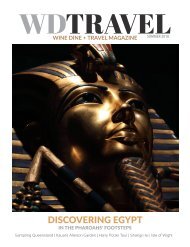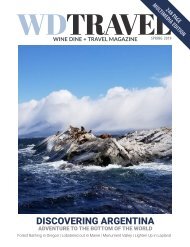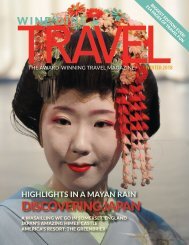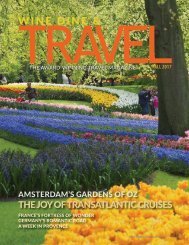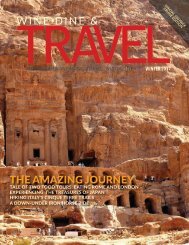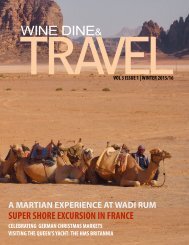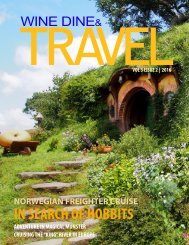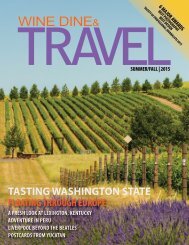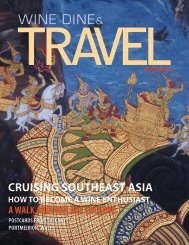WINE DINE AND TRAVEL SUMMER 2020 -- SOUTH AFRICA
What to do with a gap between two travel adventures - the end of our thrilling Kenyan safari and the start of an exotic cruise from Cape Town? What else but explore another of the world’s iconic wine regions. Since we met three decades ago, whenever possible, my husband and I seek out wine country pleasures - bucolic views, charming inns, leisurely tastings and casual fine dining. If trips bring us near vineyards - Virginia to Oregon, France to Australia, we visit for an afternoon or several days. This time our wine country destination was South Africa, one of the oldest wine-making regions outside of Europe, where Dutch and French settlers began tending vines in the mid-1600s. For a week, including Valentine’s Day when we celebrated our 31st anniversary, we explored the stunningly beautiful Winelands of the western cape, less than an hour drive from Cape Town.
What to do with a gap between two travel adventures - the end of our thrilling Kenyan safari and the start of an exotic cruise from Cape Town? What else but explore another of the world’s iconic wine regions. Since we met three decades ago, whenever possible, my husband and I seek out wine country pleasures - bucolic views, charming inns, leisurely tastings and casual fine dining. If trips bring us near vineyards - Virginia to Oregon, France to Australia, we visit for an afternoon or several days. This time our wine country destination was South Africa, one of the oldest wine-making regions outside of Europe, where Dutch and French settlers began tending vines in the mid-1600s. For a week, including Valentine’s Day when we celebrated our 31st anniversary, we explored the stunningly beautiful Winelands of the western cape, less than an hour drive from Cape Town.
You also want an ePaper? Increase the reach of your titles
YUMPU automatically turns print PDFs into web optimized ePapers that Google loves.
Bo Kaap
Bo Kapp, one of Cape Town's most distinctive
neighborhoods, also known as the Muslim or Cape
Malay Quarter, is located just a few blocks from
Greenmarket Square. Here homes, stores and
mosques are a cheerful rainbow of hot pink, lime
green, turquoise and other vibrant colors.
The community’s history is just as colorful but in
darker hues. Most residents of Bo Kaap descended
from muslim slaves from Africa, Asia, Indonesia,
and Malaysia brought by the Dutch during the the
16th and 17th centuries. The Cape Malays as they
were called, were a mixed lot -- from scholars and
religious leaders to convicts and skilled craftsmen.
As we walked the steep cobblestone streets, we
learned that the more modest homes were built by
and for the slaves, while the larger houses at the
top of the hill were for owners and managers.
Many of the homes today are B and Bs, small
restaurants, shops, galleries and grocery stores.
Climbing up and down the hills can work up a
thirst, but don’t look for a cold beer here -- no alcohol
is allowed. (Just across the street from Bo
Kaap though, several markets, bars and restaurants
serve adult beverages.)
If you’d like a little snack, be sure to try the famous
street food at a simple stall at the corner of
Helliger Lane and Rose Street. For the last 14
years Warida Conelius has deep fried the best
samosas in Bo Kaap. Cooked on site, they are super
fresh – hot and crisp. We got there early because
she sells out of everything that she makes.
Bo Kaap is home to a lively arts community and
number of outstanding galleries, mostly owned by
the artists. One of them, Art du Cap gallerie,featured
larger than life portraits of famous people
including Nelson Mandela. Owner and artist, Anthony
de Klerk, and his wife also sponsor an outreach
program of art classes for neighborhood
residents.
The community’s popularity has its downside.
We saw several signs pleading to save Bo Kaap.
Since apartheid ended, non-muslims have been allowed
to buy homes here, causing inflated home
prices and increased property taxes. As a result,
many muslims have had to move out. The city is
slowing the gentrification by limiting the percentage
of outside owners to 15 percent, although our
tour guide doubted that rule would stand because
there’s money to be made here.
94
WINE DINE & TRAVEL MAGAZINE 2020





